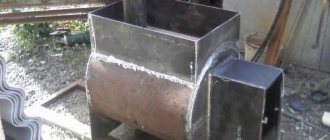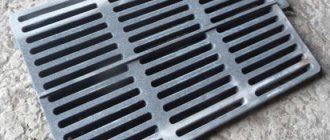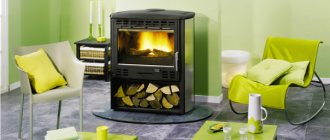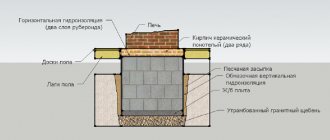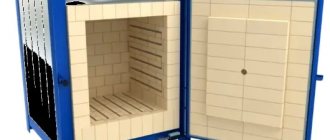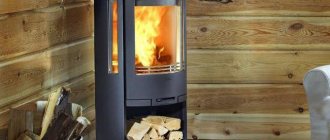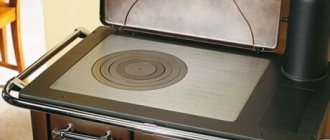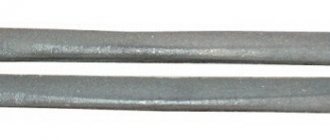close ×
It is quite possible to make a grate with your own hands in a home workshop. What is a stove grate, how best to make and install it - we will try to talk about all this in the article below.
The grate for the stove is part of the support platform in the form of a grate for laying solid fuel in the combustion chamber of the stove. The lattice can be either solid or in the form of bars laid in a row with spaces between them. The size of the grate depends on the size of the stove firebox. The material from which grates for furnaces are made in the factory is cast iron and steel. Homemade structures are assembled from steel elements.
A little history
Previously, firewood was burned on a blind hearth - combustion air was supplied through a slightly open fire door.
This method has a fire hazard - coals may fall out of the firebox. It is also difficult to accurately select the optimal combustion mode - the regulator is very rough. The ash that covered the coals over time also did not contribute to the normal combustion of fuel - it is an excellent heat insulator (in the combustion chamber of a Russian stove, this is exactly how coals were stored in the ash for the next kindling). Therefore, they began to install a grate - a grate on the hearth through which oxygen enters the combustion zone. The ash is also removed through the grate - nothing interferes with the combustion processes. The absence of a grate or its damage is not critical - the stove operates without it. True, the efficiency is somewhat lower. And the zone of intense heating of the masonry moves below the hearth - now the base of the ash chamber is also heated. And here you need to be careful if the stove is installed on a wooden base.
Features of choosing cast iron grates
When choosing a particular model, you must first of all take into account the type of fuel used. Let’s say, if you plan to heat the stove with coal, then give preference to a design with dimensions of 30 (35) x 20.5 centimeters, but if with wood briquettes or firewood, then the dimensions of the product should be from 14 x 12 centimeters to 33 x 25.2 centimeters.
Note! In addition, when choosing a grate, it is necessary to focus on the calculation that the rods of the product will be able to withstand the maximum weight of one portion of loaded fuel. In order to find out exactly how many kilograms a particular option can withstand, talk to a sales consultant
If in doubt, it is better to consult a specialist.
Another important point is the width of the gaps. In order for you to easily clean the grate from ash in the future, the area of these gaps must correspond to at least 40 percent of the total area. If this indicator is lower, then the combustion chamber will not function as efficiently, because the volume of incoming oxygen will not be enough for proper combustion. And if there is little ventilation, then gases can also accumulate there. And on the contrary, if the area of the cracks exceeds 40 percent, then incompletely burned fuel will fall into the cracks along with the residues.
Buying tips
For high-quality combustion, not only the size of the grate is important, but also the weight of the fuel that it can withstand in one laying. The rods should not deform or wear out.
The grate must have a sufficient number of holes - at least 40% of the area of the part itself. If this figure is lower, then there will not be enough oxygen to maintain the fire, and the ash will remain on the grate and clog the stove.
If the gaps in the grate have a large area, then the remaining fuel will fall from the combustion chamber into the ash pan. Fuel consumption will become uneconomical.
Optimal lattice option
Options for grates and their cost
There are various options for grates on sale for installation in stoves, fireplaces and boilers. As mentioned above, these products are made of cast iron or steel.
Cast iron should always be considered the optimal material. And the best grade of cast iron for the manufacture of heat-resistant fittings is SCh-15 (20). This marking is often placed directly on the product.
Grate grates made of steel are cheaper and weigh significantly less than their cast iron counterparts. However, their service life is much shorter, since they begin to deform under the influence of high temperatures, becoming unusable. And if the purchase is planned with the expectation of many years of daily use of the stove, then it is better not to take steel grates into account at all. They are suitable for a decorative fireplace that is lit occasionally, or for a stove that is not used often. For example, it could be an outdoor barbecue complex - you can save on the cost of the product, and for periods of long downtime, the grate can be easily removed and stored in a utility room.
Many foundries are engaged in the production of grates. But you shouldn't think. That the shapes and sizes of products, as they say, “are taken from the ceiling.” This area also has its own standardization.
For example, the products of Litcom CJSC - Rubtsovsky Foundry Complex LDV - are in wide demand. All gratings are manufactured in accordance with the STO 3-2011 standard and developed strict technical conditions. The table below shows grates of different shapes and linear parameters, as well as their cost for 2018.
The symbols are quite clear.
“RU” – grate for coal,
"RD" - grate for firewood.
Products with such indices are intended for stoves, boilers and fireplaces for domestic use with a maximum thermal power of up to 8 kW.
If a grate is required for a more powerful furnace or boiler, then a model with the added letter index “P” is purchased - it indicates the purpose of the product for industrial furnaces or boilers, with a thermal power of 8 to 100 kW.
| Illustration | product name | Linear dimensions, mm | Weight, kg | Approximate cost, rub. (2018) |
| Industrial grate RU-P-10 | 350×100 | 4.5 | 520 | |
| Cast iron household grate RU-1. | 250×250×20 | 4.05 | 520 | |
| Household grate RU-2. | 300×200 | 4.6 | 500 | |
| Household grate RD-8. | 245×220 | 4.1 | 450 | |
| Household grate RD-4. | 250×250×25 | 4.9 | 565 | |
| Fireplace grate RD-7. | 290×135 | 1.66 | 290 | |
| Household grate RU-5. | 300×250 | 3.6 | 430 | |
| Grate catalyst RD-9. | 300×200 | 4.2 | 555 | |
| Household grate RD-6. | 380×250 | 6.4 | 695 | |
| Household grate RD-5. | 300×250 | 5.65 | 695 | |
| Industrial grate RU-P-2. | 520×200 | 14.1 | 1925 | |
| Industrial grate RU-P-1. | 410×200 | 9.96 | 1430 | |
| Industrial grate RU-P-5. | 910×250 | 33.3 | 3990 | |
| Industrial grate RU-P-11.1 | 550×230 | 20.82 | 2395 | |
| Industrial grate RU-P-11.3 | 800×230 | 30.55 | 3490 | |
| Industrial grate RU-P-11 | 618×230 | 23.4 | 2685 |
Of course, the assortment of one manufacturer shown in the table does not at all limit the offer of specialized stores. To decide on the choice of this element of baked fittings, if the meaning of the abbreviation in the model name is not clear, you can consult with the seller or a specialist in this field. But it’s not worth purchasing a grate of unknown origin, as it can fail at the most unnecessary moment. And there are fakes, even those made from some alloys of unclear composition, but passed off as high-quality gray cast iron.
It is important to remember that if the stated material for the grate is cast iron, then by default it cannot be too light and attractively cheap
Price policy
A quality product cannot have a low price. High-quality cast iron parts that will last for many years are expensive. And vice versa, light and cheap ones, made from a mixture of unknown materials, will quickly become unusable.
Approximate prices for furnace grates:
| Size | Price |
| 800x200 mm | 1200-1600 rub. |
| 915x250 mm | 1100-3000 rub. |
| 260x540 mm | 400-500 rub. |
It is better to buy these products in specialized stores. They provide a wide selection of models with different materials and price categories. Consultants will help you make the right choice based on your preferences, the nature of the fuel, and the frequency of operation of the heating device.
Ways to solve the problem
If the grate is damaged, there are two options: fill the ash chamber with a brick or install a new grate.
The option of filling is acceptable only if the integrity is damaged or there are cracks and it is impossible to eliminate them at the base of the ash pit. At the same time, it would be good to replace the firebox door from a blank door to a door with a grille to regulate the flow of secondary air. But this option will definitely create a lot of unnecessary trouble and reduce the efficiency of the furnace. Therefore, we change the grate.
The grate is usually made of cast iron. Cast iron is very different from brick in terms of CTE - coefficient of thermal expansion. This indicator for iron is much higher than for ceramics. Therefore, the grate is always placed freely with a gap of 5-10 mm around the entire perimeter. Some manuals recommend filling the gaps between the masonry and the grate with sand. But this is very stupid advice. Unnecessary and even harmful. Firstly, the sand from the heat of the coals (and it can reach 1100 degrees Celsius) simply sinteres - vitrifies, tightly welding the grate to the masonry and depriving it of the necessary freedom. Secondly, after the first fire, this gap is filled with ash - a non-flammable and non-caking material. So why make unnecessary movements?
The figure shows the correct (bottom) and incorrect (top) position of the grate
Usually the grate is placed in a brick trough or in grooves selected in the brick. If the integrity of these grooves is damaged and it is impossible to restore them, you will have to come up with some kind of supports. Sometimes they try to get out of the situation by driving nails, metal plates, etc. into the seams of the masonry. All this is in vain - the metal is quickly tempered and ceases to hold the grate, and more massive pieces of iron are unacceptable - they will tear the masonry.
Initial information
Self-made structures made of steel, when compared with their brick counterparts, are distinguished by the speed of construction and increased heat transfer. To carry out the work, it is enough to find a pipe whose diameter will be approximately 50 centimeters. Such products are especially relevant for small objects.
Requirements
Approximately the following pipe needs to be prepared.
- The heating structure must be located in a place where reliable fire protection is provided for materials subject to easy ignition.
- The area occupied by this object should not exceed 0.15 percent of the useful square footage of the heated room, since it is not very comfortable to carry out water procedures in a cramped environment.
- The side surfaces of the structure must be covered with heat-insulating materials so that the risk of burns is minimized.
- When installing, you should take care of the correct location of the stove, because the heat emanating from it should spread in different directions, thereby ensuring high-quality heating.
Basic elements
When making an iron stove for a bathhouse with your own hands, every novice craftsman must familiarize himself with the main components that make up the structure.
Any of the fragments listed below performs some function, so it is important to study all the details in full.
The structure of a sauna stove with water supply.
- The firebox is the main chamber where organic fuel is usually burned to heat the walls and then the surrounding air.
- The ash pit is located below the previous chamber, ensuring the collection of ash, which is formed as a result of the combustion of organic substances.
- The stone container allows you to lay cobblestones of jadeite, gabbro-diabase, crimson quartzite or other high-temperature resistant analogues.
- The pipe is a hollow product that is necessary to remove combustion products from the main chamber.
- The grate is an element inside the firebox that makes it possible to hold a layer of solid substance intended to produce thermal energy.
- Blower and firebox doors allow you to control the flame by covering it, which leads to a decrease or increase in oxygen inside.
- A pipe valve is usually made in the form of a control element that moves perpendicular to the working medium.
Shown is a homemade grate made from rebar.
Attention! If the building combines a washing compartment and a steam room, then the hot water tank is installed directly on the stove. However, in such a bathhouse it is also possible to have stands above the stones.
Classification of grate
Cast iron grates for stoves were and are still the best option. Steel is less resistant to this mode of operation and is not able to accumulate heat, as cast iron does. Therefore, despite the heaviness of the material, it is cast iron wood-burning stoves - Harvia, for example, and cast iron grates that are considered the best. Moreover, this applies to models both for baths and for heating living quarters.
However, this classification exists:
- steel gratings are lighter. If you know how to handle a welding machine, they can be made with your own hands - for a bath structure, for example. However, the material burns out faster because it is less resistant to chemically aggressive substances.
- Cast iron grates for sauna stoves or other structures are much more stable and, therefore, have a long service life.
Another classification of devices is related to the type of device.
- Fixed - usually a lattice with different sizes for different types of construction. This element does not change its parameters and does not move. There are several types of grating: tiled flat - lattice flat rectangle. This is the most popular option and is used for any wood-burning sauna stoves, solid fuel heating boilers, fireplaces, and so on. The photo shows the Harvia model.
- basket - designed for open fireboxes and originally developed for cooking. This device is no longer used, and there are almost no open fires, so the popularity of this model is not great;
- beam - in appearance they resemble a construction beam. The lattice of them is assembled with your own hands, choosing the appropriate size and quantity. This is the best method for fireboxes of non-standard sizes.
Movable grates are extremely rare in everyday life, as they are designed for long-term heating devices. Such an element consists of several gratings and a shaft. When changing the angle, the size of the clearance also changes, which allows you to effectively regulate the heating. Based on the angle of rotation, devices are divided into swinging and full-rotating.
The chain grate belongs to the same category: its elements are connected by chains. However, in practice it is extremely rare, since it does not ensure complete combustion.
Conclusion
When choosing a high-quality grate, you should take into account the design features of the stove. The choice of a specific design and lattice components depends on the nature of the fuel. A grate for a sauna stove made of cast iron will last longer than the same one made of steel or other metals.
The weight of the fuel itself is also of great importance. Installing gratings does not require special knowledge. You can correctly place the grates in the oven yourself; it is enough to take into account only a few nuances. With the right choice of material and installation, they will last you a very long time.
Specifications
There are many types of stoves, varying in size, type of fuel used, and other characteristics. Therefore, the grate for them will also be different. As for the material of the stove itself, it does not directly affect the choice. Grates are installed in brick, steel, and cast iron devices.
Type of design
There are gratings:
- monolithic;
- typesetting;
- refrigerated.
Monolithic are solid structures. Dimensions are selected depending on the depth and width of the combustion chamber.
Available to fit all standard firebox sizes. This option is the easiest to install.
The typesetting version is made up of individual rod elements. It is used if a standard one cannot be selected, for example, in non-factory-made ovens.
Important! Often the rods are wedge-shaped. When installing, they are positioned with the narrower part down. This increases service life
This increases service life.
Cooled ones are used in systems with heat exchangers. They are made of tubes through which coolant passes. Thus, the grate itself is cooled, and the overall efficiency increases. This option is more often used in solid fuel boilers. The temperature inside the chamber reaches 1000°C. Thanks to cooling, the material can withstand a similar thermal load.
Form
The grate bars differ in the shape of the canvas. Different types are used in different designs. The following types of gratings are available:
- flat;
- basket;
- movable;
- beam
Photo 1. Basket grate made of cast iron. This type of device is usually installed in fireplaces.
Flat (or tiled) - the most common type. They are installed not only in stoves, but also in boilers that burn solid fuel, as well as in fireplaces. They have a rectangular shape. The dimensions are standard, selected depending on the dimensions of the fuel chamber.
Baskets have curved edges, which is why the whole structure resembles a basket. Such structures are placed in open-type ovens intended for cooking. Since such stoves are rare nowadays, and the parts for them are also not very common.
Movable grates are installed in long-burning furnaces, where it is necessary to regulate the air flow. The design allows for the possibility of changing the width of the gaps. They have several sections and a shaft, thanks to which movement occurs. Rotation axes can be horizontal or vertical. An additional advantage is greater ease of cleaning.
Beams consist of individual crossbars (beams), which can be single or double. They are typically used in non-standard sized ovens.
Material
The temperature in the furnace is quite high, which forces craftsmen to make grates from special metals:
- The most durable is a cast iron oven grate.
- There are also steel parts, the most popular of which is antipyretic steel. Such grates are not susceptible to oxidation and corrosion when the flame burns, and also do not deform. These devices can have different sizes and shapes, the abundance of which makes it possible to choose a grate even for a non-standard stove model.
Size
The dimensions of the product depend on two parameters:
- dimensions of the furnace combustion chamber;
- type of fuel used.
In equipment operating on wood, peat and fuel briquettes, a width of 150-350 mm (in increments of 50 mm) is most often used.
The depth is usually 180 or 250 mm. The largest possible dimensions of standard models are 900x800 mm.
When coal burns, more harmful substances are formed. Therefore, the dimensions of the grille should be larger, from 300-350 mm on both sides.
In any case, gaps of at least 5 mm are left at the edges. They serve to compensate for expansion when heated.
Attention! When choosing a size, the weight of one load of fuel is also taken into account. Dimensions, especially thickness, are selected in such a way as to withstand this load
Solid and stacked
For convenient use, you can choose different grate designs:
- Solid. They look like monolithic gratings; they cannot be broken down into smaller components. Most manufacturers have standard oven grate sizes, focused on the most popular oven models. The choice of sizes of solid parts is quite large. Preference should be given to a certain product taking into account the fuel surface area.
- Stacked grates. They have a collapsible shape and can be assembled independently. The number of their components depends on the required area of the device. This guarantees their versatility, because the oven grate can be made in any size and is suitable for non-standard ovens.
Do-it-yourself grate: materials, design, stages of work
02/13/2019 Emmett Brown Homemade
In private homes, stoves, boilers and fireplaces are often installed, which, despite their differences, have one common detail - a grate. It may differ in its shape, size and material, but its purpose remains the same in all designs.
The performance of stoves, fireplaces and boilers, as well as their efficiency, largely depends on whether the element is manufactured correctly, how accurately it is placed in the combustion chamber, and also on the material from which it is made.
Peculiarities
The grate is made by hand as a single piece; most often, cast iron is used for its production. The grille of the structure has holes through which air is drawn to the fuel.
The part is laid in such a way that the grille holes are directed from the door opening to the rear wall. For large combustion chambers you will need several grates.
It is quite possible to make a grate with your own hands. It is an important element in the combustion chamber, thanks to which it is possible to obtain efficient combustion of fuel. The designs of modern furnaces and boilers are constantly changing, and details are being improved. But there is a functional element that you can’t do without. This element is the grate.
The grate serves to support wood, coal and fuel briquettes. Through its holes, ash pours down, thereby freeing up space for a new batch of firewood. Grate bars vary in design and are made from different materials.
What to make grates from
To make the grate in the furnace, fire-resistant steel and cast iron are used. Since the grate is constantly exposed to combustion, cast iron is considered the best option for its manufacture.
Even the strongest steel will become damaged over time due to exposure to constant fire. And the combustion temperature of coal is considered to be one of the highest among all types of fuel. It is for this reason that cast iron is chosen for the manufacture of the grate. When exposed to high temperatures, steel material has the ability to oxidize, and in the future it rusts and breaks down.
The size of the grate depends on the fuel that will be used in the future. For everyday use, two designs are recommended - solid and composite.
The first option consists of a cast iron grate, which is selected according to the size of the combustion chamber. The second type is assembled from individual elements.
The size of a composite grate is determined in the same way as a solid one, based on the size of the firebox. In addition to differences in type, devices are also divided by functionality.
The design of the cast iron grate comes in two types: full-rotating and swinging. In the first case, the elements have the ability to rotate horizontally by 180 degrees, which allows you to dump ash and slag.
This design involves grooves in the combustion chamber for additional holes. It is extremely difficult to make a full-circle system at home.
In the second design, the elements have cradle-like movement elements, rotating around at an angle of 30 degrees. This system has the ability to loosen accumulated slag.
By design, the grate can be chain or pipe. In the first case, the model resembles a conveyor belt. In the second, it is made of pipes and has a cooling function.
The cooled grate consists of a cast coil, which is made of cast iron. This type is used in water heating and pipe water supply systems. Coolant circulates inside the cooled grate device. Cooling is used when burning coal, since its temperature is a thousand degrees.
Making a grate at home
You can make a grate with your own hands only from steel, since it is almost impossible to make a structure from cast iron at home.
For work, it is better to choose fire-resistant steel, but this is not a prerequisite. It is necessary to take into account what type of fuel the grate will be made for; its size depends on this.
For coal, a design of 300x300 mm or 350x300 mm is suitable, and for burning wood, the size of the grate will be from 140x120 mm to 300x225 mm.
Using simple iron, it is necessary to plan the stages of work so that in the end the grate is thick enough. You can use steel strips and reinforcement. Before you start making a grate with your own hands, you need to take the dimensions in advance. The next stage is the production of the frame.
The frame is considered the basis when installing the grate; later, parallel elements are welded to it. It is important to choose the correct distance between elements in the frame. Here it is necessary to take into account that ash does not leak through the holes, and air can circulate freely to maintain combustion.
Holes in the grill should not occupy more than 40% of its area. Do not forget that compliance with safety regulations has not been canceled. It is worth taking care of clothes and shoes in advance, especially at the welding stage.
Grill installation
Metal tends to expand at high temperatures, so the grate must be installed with a small gap of no more than 5 millimeters in each direction.
The ledge in the combustion hole needs to be cut off; the grate itself will be located on it in the future. In a brick stove, the location for the grate is generally chosen below the opening of the firebox door by one brick. This must be taken into account to ensure that burning wood and coals do not fall on the floor.
At the installation stage, you should not install the grates tightly, since when heated the material is capable of deformation. This can lead to product failure and cracks in the oven itself.
It is also necessary to take into account that if triangular rods are installed in the grate, then it must be laid with triangles down.
Recommendations
The fuel material must be completely burned, and to achieve this goal, an optimal amount of oxygen must be supplied.
Therefore, the total area of the distance between the grates is no more than 60% of the total area of the grate.
If the distance is smaller, a small air flow will enter the stove; this will not be enough to maintain the combustion process in the combustion chamber.
If the distance between the grates is large, the fuel material will fall without having time to burn out. This will lead to an increase in combustion consumables.
The cast iron grate for the stove provides good traction and is used for burning wood, coal and fuel briquettes. Cast iron still occupies a leading position in the manufacture of grates. Since it is least susceptible to deformation at high temperatures.
Conclusion
When creating grate bars for boilers or furnaces with your own hands, you need to consider for what purpose they are planned. After that, all that remains is to clarify the dimensions depending on the combustion compartment. Even a beginner can weld such a structure, observing safety precautions and adhering to recommendations.
Source: .ru
Source: https://labuda.blog/200413.html
Review of grates for fireplaces and stoves
Modern wood stoves bear little resemblance to their ancient counterparts, both externally and internally. They are distinguished by their smaller size, high thermal productivity, and in the combustion part, grates for furnaces have become a traditional part. Not all city dwellers know what a grate is, although various heaters, hearths, potbelly stoves and fireplaces are becoming common attributes in a country house or dacha.
The grate is a cast-iron grate for the stove, separating the firebox and the ash compartment, and serving for laying solid fuel (wood, coal, briquettes). Oxygen from the blower enters through the cracks, thereby enhancing combustion and increasing productivity. Firewood and coal burn with a minimum residue, and ash and ashes fall into the ash pan.
Not every metal is suitable for grates for fireplaces and stoves, because the grate experiences the destructive effects of high temperature and oxygen and gradually burns out. The best and most reliable material is cast iron, which is also used for the manufacture of fittings: doors, latches, decorative elements.
Types of cast iron grates
They come in four types:
1. Tile models are a standard size rectangular grate, used in stoves, fireplaces and boilers. This is a popular shape widely used in prefabricated metal stoves.
2. Beam grates - a stacked structure made of cast iron slats, single or cast in pairs. They are good for non-standard fireboxes of homemade hearths; you just need to take into account the standard length of the structures when forming the installation site. The beams must lie freely and be removed from the firebox, and the gap for expansion must be at least 5 mm, otherwise deformation of the metal and damage to the masonry is inevitable.
3. The basket type was previously used in the open fireboxes of ancient kitchen hearths, but now they have become irrelevant.
4. The movable grate structure is used in long-burning heating stoves. On it you can adjust the width of the gaps, thereby cleaning the oven.
Selection of grates for different fuels
For long and reliable service, the grate must be selected based on the type of fuel used. For firewood and briquettes, grates 330 x 252, 300 x 252, 250 x 252, 250 x 180, 140 x 180, 140 x 120 mm are used. For coal, they should be 350 x 205 or 300 x 205 mm, which is due to the large amount of harmful combustion products that it emits.
It is important that the thickness of the rods support the maximum weight, and the total area of the gaps is 40% of the entire surface of the slab. This applies to both stacked beam grates and industrial casting slabs
Without sufficient ventilation capacity of the grate, the stove will burn poorly and gases may accumulate in it. If the gaps are excessive, fine coals fall into the ash pan without having time to burn out, which will increase fuel consumption.
Assortment and prices
You can buy cast iron grates for a wood-burning stove in branded stores of stove companies, where there is always a wide selection and high-quality material is used. Focus on the cost and weight of the product. Too light and cheap products are not cast iron.
As a rule, heat-resistant fittings are cast from SCh 15 (20) grade; it has optimal heat resistance. Steel grates are cheaper, but over time they deform and become unusable. A good solution would be a beam with a ribbed surface, which reduces the contact of hot fuel with metal. This design extends the service life.
It would seem that a wood-burning stove has reached perfection over the millennia of its existence, and it is quite difficult to introduce something not just new, but truly useful into its design. However, progress is able to reach even the most traditional and static systems. In particular, it has become popular to install grates for the furnace in the firebox, reduce its size, and also promote an increase in heat output.
Design features and types
The grate is a grate with separate elements that perform the function of maintaining fuel in the combustion chamber. Based on the design, it is customary to distinguish the following types:
- Flat tile grate. This grate for the furnace is the most common. It is also used in boilers and fireplaces. Its difference lies in certain dimensions. This nuance must be taken into account when laying the stove manually. An installation platform is required for installation into a heating device. It should be easy to remove and the gap should be at least 50mm. After all, almost all grates are made of cast iron, and when expanded, it can cause harm to the combustion chamber and ash pan.
- Beam lattice. This cast iron grate for the stove is stackable. The number of elements must correspond to the dimensions of the firebox. The beam option is the best for arranging a non-standard handmade stove. However, it is necessary to remember about the standards for its length.
Beam grate for oven
- Basket-shaped. Such grates can be used in open fireboxes. Recently, they are installed quite rarely, because a heating device of this type has lost its relevance.
Basket-shaped grate
- Movable grid. The main function in this case is to limit the size of the gap between the grates through the shift of the moving part in the horizontal plane. This is quite convenient for the automatic operation of long-burning stoves.
Movable grate design
Criteria for selecting grates for a furnace
The choice of grate is determined by several factors, which include the following:
- Type of heating device (structure).
- The type of fuel used - the grate model will depend on this point. If you plan to heat the stove with coal, then you should purchase more massive grates that can withstand considerable mechanical load and extremely high temperatures. Lighter weight products are suitable for wood fireplaces and stoves.
- The grate must correspond in size to the seat in the combustion chamber. More precisely, the dimensions of the grate are usually immediately included in the design of the furnace, based on the sizes of these products offered for sale.
- The distances between parallel grate bars for wood-burning stoves must total at least 40% of the grate area. This factor will help to avoid difficulties when cleaning the product from ash. In addition, gaps less than recommended will create obstacles to the free circulation of air flow. And this, in turn, will lead to a decrease in the productivity of the heating device, as well as to a decrease in the level of safety of its operation. Insufficient air exchange creates difficulties both for complete combustion of fuel and for normal traction. And the delay of combustion products is unacceptable, as this is fraught with very serious consequences.
If the gaps of the grate are larger than necessary, then not only ash, but also unburned fuel particles will fall into the ash pan. The consequence is a completely unnecessary waste of fuel, since unburned particles of firewood or coal that have fallen into the ash pan will no longer produce the expected heat transfer. And in this case, everything is not very good with security.
Dimensions
Another condition for choosing a grate for a stove is its length and width. The sizes of the grate for the furnace are different, they are determined by the type of fuel:
- For light firewood or briquettes, grates from 140x120 mm to 330x252 mm are sufficient.
- For coal, larger parameters are needed: 300x300, 350x300, since this fuel emits a large amount of harmful substances when burned.
Variety of grate sizes
Cast iron grate for furnace
Over the centuries, the external and internal design of the stove has been changed and improved in order to increase heat output. Structurally, elements such as the valve, stove, oven could change over time, but an important element of the hearth remains unchanged - the cast-iron grate for the stove.
The configuration, dimensions, and cost of the grate depend on the design features of the furnace, as well as the type of solid fuel. The grate is a grate installed in the firebox, dividing it into two parts: the ash pan and the combustion chamber. It provides the formation of an air flow that supports the combustion process of solid fuel due to natural convection.
Tasks and types
Solid fuel is placed on the stove grate, and the ash formed during its combustion is poured through the grate holes into the ash pan. The resulting slag prevents the grate from overheating. The grate provides high-quality draft from bottom to top, and together with the oven door allows you to regulate the strength and duration of the flame.
Cast iron and steel are used to produce gratings. Cast iron grates are installed in stoves and fireplaces because they do not require special operating conditions and can withstand high temperatures well. Steel grate bars are used primarily in industrial workshops. The dimensions of cast iron grates for a stove, as well as their weight, depend on the type of fuel used.
Depending on the type of construction, there are two types of cast iron grates:
The one-piece type of grates cannot be disassembled; it is selected individually for the stove depending on the size of its firebox.
Prefabricated grate bars consist of a certain number of elements from which a grate of the required dimensions can be assembled.
There are four types of grate shapes:
- Tiled flat model
A universal flat rectangular grille, suitable for most solid fuel fireplaces, boilers, and stoves. To buy one, you need to know exactly the size of the firebox.
Basket
A design of this type was used on open fireplaces; today it is obsolete.
Beam
The design of this type is a kit model consisting of single or double cast iron slats, from which you can assemble a grill of non-standard dimensions. When using a beam grate, the slats must be freely placed in and out of the firebox, while there must be a gap for expansion of at least 5 mm to avoid deformation of the metal and masonry.
Movable
A long-burning stove is usually equipped with a movable grate. This is a structure consisting of a shaft and several moving sections. The vertical and horizontal axis of rotation of the shaft improves the process of fuel combustion and cleaning the grate from ash, while the width of the gaps in it is adjustable. A rotation angle of 30 degrees leads to loosening of the slag and shedding of ash into the ash pan. The angle can also be 180 degrees, but the installation of such a movable grate requires the presence of special recesses in the brick, so it has a high cost and limited use.
A separate type are cooled grates, or KROK, installed in hot water furnaces and water heating boilers. They are made from solid cast iron pipes. Air is supplied through special holes, showering the ash, while maintaining a temperature of up to 1000 degrees of hot solid fuel. Coolant circulates inside the tubes, cooling them.
Selection rules
The selection of the appropriate grate model should be based on the type of fuel used. The size of the grate and the weight it must withstand when loading firewood into the firebox depend on this. Small grates are used for wood stoves and fireplaces, and large grates are used for coal stoves. The minimum grate size is 140x120 mm, the maximum is 800/900x200 mm. The optimal size for burning wood is 140/330x120/252 mm, for coal - 350/300x205 mm.
When installing a grate in the firebox of a fireplace or other stove, it is necessary to make recesses around its perimeter of at least 5 mm, since the metal will expand when heated. The ledge on which it will be installed must be hewn. If the installation is in a brick fireplace, the grate should be placed one brick below the door so that the coals do not fall out of the firebox. After laying, the grooves are filled with sand (without adding cement). Correct installation of the grate is carried out when the grate is placed with expanding gaps between the rods downwards, and not upwards.
It doesn’t matter what shape or cost the grate has. Its quality can only be judged by the material from which it is made, the thickness of the grille bars and the size of the gaps between them.
What to make grates from
To make the grate in the furnace, fire-resistant steel and cast iron are used. Since the grate is constantly exposed to combustion, cast iron is considered the best option for its manufacture.
Even the strongest steel will become damaged over time due to exposure to constant fire. And the combustion temperature of coal is considered to be one of the highest among all types of fuel. It is for this reason that cast iron is chosen for the manufacture of the grate. When exposed to high temperatures, steel material has the ability to oxidize, and in the future it rusts and breaks down.
Grate for the furnace: types, sizes, installation rules
The designs of modern stoves are constantly being improved, changed, and supplemented. However, there are elements whose functions are difficult to do without. As an example, you can install grates for the oven (grid).
The grate is a part of the combustion chamber that supports logs, coal, and fuel briquettes. Through the cracks in it, the ash falls down, freeing up space for a fresh portion of fuel. There are different design solutions for these elements; they are made from different materials. From the article you will learn how to choose and how to properly place the grate in the oven.
Cast iron grate for oven flat
Why is it needed?
As has already become clear, the grate is a grate that allows the air flow to penetrate directly to the combustion center below, and the ash to be removed through the holes to a specially designated place for it. So why do we need grates in a furnace? Installing a grate in a furnace allows you to solve a number of problems:
- Divides the combustion chamber into two zones - the combustion chamber itself and a niche for ash.
- Used for placing and drying fuel.
- Distributes the air flow from the ash pan.
- Promotes good traction.
- Together with the door it makes it possible to control and regulate the flame.
The grate, which is intended for installation in the stove, cannot be made from any metal. Since it is constantly exposed to high temperatures and oxygen, it can begin to oxidize very quickly. Only cast iron can survive in this environment for a long time
What is needed for production?
It is possible to make a grate with your own hands. What to make a grate for the oven from? It is better to use heat-resistant steel as a material, because it is impossible to work with cast iron at home. To make the grille, you can use any materials that have heat-resistant characteristics. This could be fittings, corners, steel pipes or strips of metal.
To make grate bars you will need:
- the metal from which the grille will be made,
- steel rods for creating partitions;
- ruler, tool for making marks;
- grinder for cutting material;
- welding.


